- Joan Miró Paintings: Early Life and Influences
- Catalan Beginnings: How Early Life Shaped Joan Miró Paintings
- From Figurative to Abstract: The Evolution of Joan Miró Paintings
- The Key Phases in Joan Miró’s Artistic Development
- Joan Miró’s Iconic Abstract Paintings
- Dive Deeper into Miró’s World
- Sources
- Quick Facts and FAQ on Joan Miró and His Masterpieces
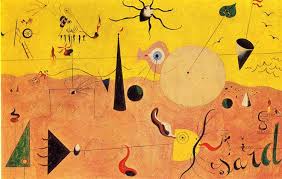
Do you remember the first time you encountered a Joan MiróSpanish Catalan artist Joan Miró (1893 – 1983) is famous for his works in painting, sculpture, and ceramics. His work is strongly influenced by his hometown Barcelona, the scenic seaside, and the distinct style of that area. From early on, he was exposed to the arts through his parents’ professions: His mother was a goldsmith, father worked as a watchmaker. More painting?
I do.
It was a scorching summer day in Barcelona, and I stumbled into the Fundació Joan Miró. The vibrant colors and zany forms in his pictures instantly hypnotized me. It felt like being pulled into a dream. Miró’s magical worlds had a captivating quality that gripped you.
Joan MiróSpanish Catalan artist Joan Miró (1893 – 1983) is famous for his works in painting, sculpture, and ceramics. His work is strongly influenced by his hometown Barcelona, the scenic seaside, and the distinct style of that area. From early on, he was exposed to the arts through his parents’ professions: His mother was a goldsmith, father worked as a watchmaker. More is considered a pioneer of abstract art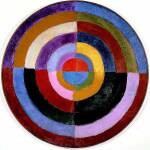 Abstract artworks diverge from depicting recognizable scenes or objects and instead use colors, forms, and lines to create compositions that exist independently of visual references from the natural world. This movement, which gained momentum in the early 20th century, was propelled by artists such as Wassily Kandinsky, Piet Mondrian, and Kazimir Malevich. These artists aimed to explore spiritual, emotional, and More.
Abstract artworks diverge from depicting recognizable scenes or objects and instead use colors, forms, and lines to create compositions that exist independently of visual references from the natural world. This movement, which gained momentum in the early 20th century, was propelled by artists such as Wassily Kandinsky, Piet Mondrian, and Kazimir Malevich. These artists aimed to explore spiritual, emotional, and More.
His style is a playful, deep fusion of abstract elements and surrealismSurrealism was a 20th-century philosophical, literary, and artistic movement seeking to channel the unconscious to access the imaginary. Proponents of Surrealism rejected the notion of understanding life in rational and conventional terms in favour of asserting the value of the unconscious mind, dreams, the strangely beautiful, and the uncanny. André Breton, the leader of a group of poets and artists More.
He has left a lasting impression on the art world with his bold colors and imaginative forms. Among art lovers and creators, they continue to inspire and provoke thought.
In this post, we’ll talk about some of Miró’s most iconic abstract paintings. You’ll learn about the stories behind these masterpieces and why they matter in the art world.
Let’s explore together and unravel the magic behind his celebrated art.
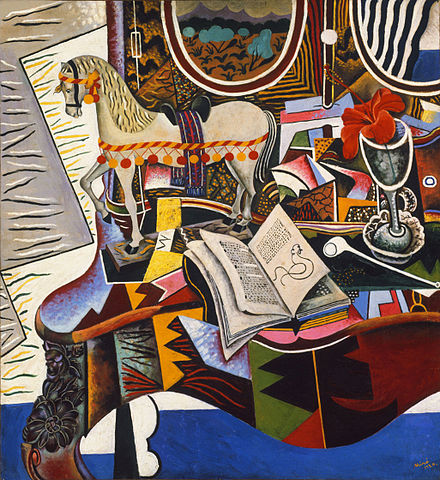
Joan Miró Paintings: Early Life and Influences
Joan MiróSpanish Catalan artist Joan Miró (1893 – 1983) is famous for his works in painting, sculpture, and ceramics. His work is strongly influenced by his hometown Barcelona, the scenic seaside, and the distinct style of that area. From early on, he was exposed to the arts through his parents’ professions: His mother was a goldsmith, father worked as a watchmaker. More was born in 1893 in Barcelona, Catalonia. He was raised in this lush region, where there was a thriving art scene and a wealth of cultural traditions. The vibrant festivals, the Mediterranean coast, and Catalan folklore greatly impacted his artistic vision.
Miró’s father was a watchmaker, and his mother was a goldsmith. Despite holding these practical professions, they encouraged him to engage in art. He joined the Barcelona School of Fine Arts at quite a young age, where he encountered various styles of art. The burgeoning local Catalan art scene as well as modern artists helped him to create his own style in this initial stage of his career.
Catalan Beginnings: How Early Life Shaped Joan Miró Paintings
Alongside the local avant-garde, Miró was also deeply fascinated by the European vanguard. He was an admirer of Van Gogh, Cézanne and Picasso. Their technical boldness and innovative painting techniques appealed to him greatly. These eclectic influences are mirrored in Miró’s paintings of his initial stage in which he experimented with diverse forms.
From Figurative to Abstract: The Evolution of Joan Miró Paintings
Miró processed slowly and inconsistently from figurative to abstract art. His early works, still largely figurative, mainly reflected the landscape and people of the Catalan countryside. But step by step, as he became more proficient in his craft, he started to simplify shapes and use colour in a more liberated, expressive manner.
By the 1920s, Miró began to embrace abstraction fully. His time in Paris introduced him to SurrealismSurrealism was a 20th-century philosophical, literary, and artistic movement seeking to channel the unconscious to access the imaginary. Proponents of Surrealism rejected the notion of understanding life in rational and conventional terms in favour of asserting the value of the unconscious mind, dreams, the strangely beautiful, and the uncanny. André Breton, the leader of a group of poets and artists More, which deeply influenced his work. Vibrant colors and simple shapes dominated his first abstract paintings, changing his style dramatically towards a surreal nature.
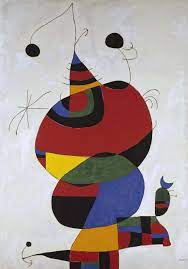
The Key Phases in Joan Miró’s Artistic Development
During his time in Paris, Miró developed a visual language that set him apart from all the artists around him. He was able to merge the essentials of surrealismSurrealism was a 20th-century philosophical, literary, and artistic movement seeking to channel the unconscious to access the imaginary. Proponents of Surrealism rejected the notion of understanding life in rational and conventional terms in favour of asserting the value of the unconscious mind, dreams, the strangely beautiful, and the uncanny. André Breton, the leader of a group of poets and artists More with pure abstraction.
The following years of his career were characterized by his iconic style: playful forms and a dreamlike vibe. His work of the 1930s and 1940s was further marked by a more politicized engagement focusing on the crisis in Spain and the wider world. But even in these works, he never compromised his devotion to abstract and surrealist ideals. In the 1960s, he had firmly established himself as one of the masters of abstract art—a legacy that still inspires artists to this day.
The transformation from figurative to completely abstract paintings shows Joan MiróSpanish Catalan artist Joan Miró (1893 – 1983) is famous for his works in painting, sculpture, and ceramics. His work is strongly influenced by his hometown Barcelona, the scenic seaside, and the distinct style of that area. From early on, he was exposed to the arts through his parents’ professions: His mother was a goldsmith, father worked as a watchmaker. More ability to push boundaries. His path through various periods of his artistic evolution has made him a cornerstone in the study of modern art.
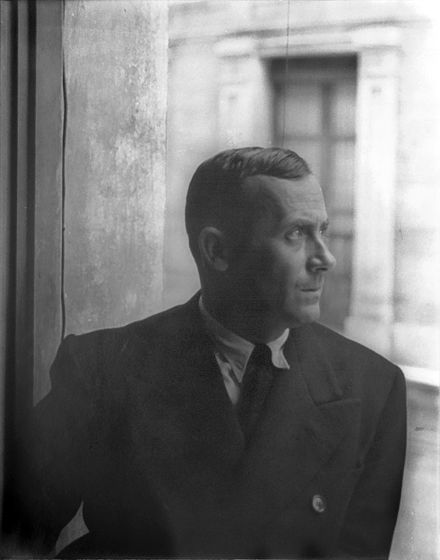
Joan Miró’s Iconic Abstract Paintings
Joan Miró’s abstract paintings are proof of his unique spirit and genius. Every piece is a window into this colorful and imaginative world, as bizarre as imagination can get.
The Farm (1921-1922)
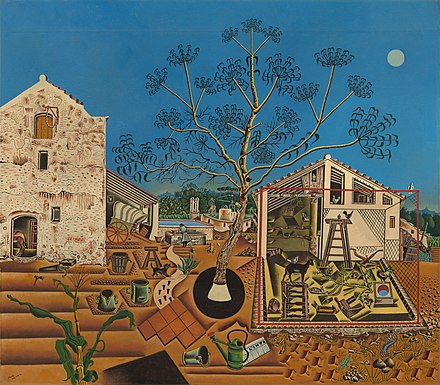
The Farm (1921-1922) marked an important moment in Joan MiróSpanish Catalan artist Joan Miró (1893 – 1983) is famous for his works in painting, sculpture, and ceramics. His work is strongly influenced by his hometown Barcelona, the scenic seaside, and the distinct style of that area. From early on, he was exposed to the arts through his parents’ professions: His mother was a goldsmith, father worked as a watchmaker. More development as an artist. It is arguably a key piece within the sphere of contemporary art.
So what is The Farm all about? It’s a detailed composition showing his family’s farmhouse in Mont-Roig del Camp, Catalonia. In this painting, Miró fused folk-art features with his newly developed surreal style to present the intricacies of rural life.
- Imagery and Detail: Miró deliberately placed animals, plants, tools, etc. in his composition to carefully conjure a scene. The combination makes for a vivid landscape that mirrors Catalan rural life.
- Whimsical Bits: When you first look at The Farm, it seems like an ordinary landscape. But a closer look reveals Miró’s bold, distinctive style. The artist combines exaggerated proportions with whimsical details, such as a tree with ginormous leaves and a small ladder.
The Farm plays a vital role in Miró’s shift from more realistic art to abstraction:
- Transition to Abstraction: This work is one of his first steps away from traditional methods of representation. The composition is not entirely removed from reality, but the surreal elements signify the dawn of his path toward abstraction.
- Bridge Between Styles: The Farm served as a forerunner to Miró’s later, more abstract creations. This combination of reality and imagination paved the way for many subsequent, iconic Joan MiróSpanish Catalan artist Joan Miró (1893 – 1983) is famous for his works in painting, sculpture, and ceramics. His work is strongly influenced by his hometown Barcelona, the scenic seaside, and the distinct style of that area. From early on, he was exposed to the arts through his parents’ professions: His mother was a goldsmith, father worked as a watchmaker. More paintings.
The Farm is not only a reflection of Miró’s deep connection to his Catalan heritage, but it also shows how his vision as an artist was developing. If you are a fan of Joan MiróSpanish Catalan artist Joan Miró (1893 – 1983) is famous for his works in painting, sculpture, and ceramics. His work is strongly influenced by his hometown Barcelona, the scenic seaside, and the distinct style of that area. From early on, he was exposed to the arts through his parents’ professions: His mother was a goldsmith, father worked as a watchmaker. More paintings, this artwork is a great starting point for understanding his development and the impact he had in the world of art.
The Tilled Field (1923-1924)
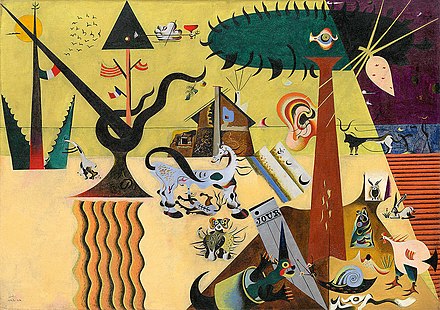
The Tilled Field (1923-1924) is another key piece in Joan Miró’s oeuvre. The painting combines abstract elements with a strong connection to his Catalan roots.
- Abstract Elements: The painting shows a vibrant, fragmented landscape filled with abstract shapes. The artist uses a variety of forms to represent natural elements such as the sun, trees, and animals. Each element is simplified and abstracted, creating a composition that feels dynamic and harmonious at the same time.
- SymbolismSymbolism was a late 19th-century art movement of French, Belgian, and Russian origin. Poets and fine artists were seeking to represent absolute truths using metaphorical images in reaction against realism and naturalism. Content of both images and poetry were suggestive contents to express mystical ideas, emotions, and states of mind. Paul Gauguin, Nave Nave Mahana (1869) The term was coined More: Even though the abstract shapes and vibrant colors seem random at first, each of them carries a symbolic meaning. The fragmented landscape represents the connection between nature and life, a recurring theme in Miró’s work.
Miró’s Catalan heritage in The Tilled Field is referenced multiple times:
- Catalan Heritage: The painting is deeply rooted in Miró’s love for his homeland. The tilled field itself is a symbol of the Catalan countryside, representing the hard work and simplicity of rural life. Miró’s use of colors and forms is inspired by the landscapes and traditions of Catalonia.
- Cultural References: Elements within the painting, such as the Catalan flag and local fauna, highlight Miró’s cultural identity. These references make the work a personal tribute to his roots.
The Tilled Field offers a fascinating glimpse into how the artist balanced abstract art Abstract artworks diverge from depicting recognizable scenes or objects and instead use colors, forms, and lines to create compositions that exist independently of visual references from the natural world. This movement, which gained momentum in the early 20th century, was propelled by artists such as Wassily Kandinsky, Piet Mondrian, and Kazimir Malevich. These artists aimed to explore spiritual, emotional, and More with personal and cultural significance. It’s a testament to his ability to infuse abstract forms with deep meaning.
Abstract artworks diverge from depicting recognizable scenes or objects and instead use colors, forms, and lines to create compositions that exist independently of visual references from the natural world. This movement, which gained momentum in the early 20th century, was propelled by artists such as Wassily Kandinsky, Piet Mondrian, and Kazimir Malevich. These artists aimed to explore spiritual, emotional, and More with personal and cultural significance. It’s a testament to his ability to infuse abstract forms with deep meaning.
Harlequin’s Carnival (1924-1925)
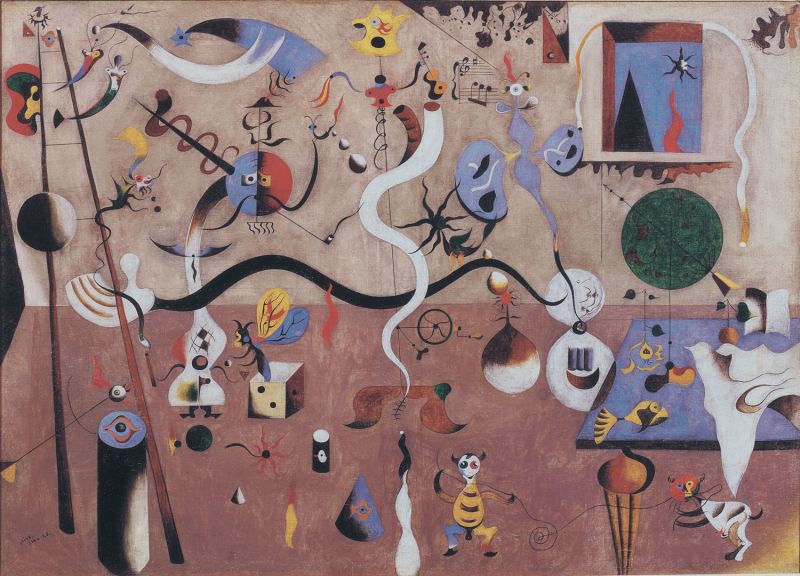
Joan Miró’s Harlequin’s Carnival, created in 1924 – 1925, is a vivid, chaotic masterpiece. Filled with vibrant and fantastic forms and images, it demonstrates the artist’s unique form of surrealismSurrealism was a 20th-century philosophical, literary, and artistic movement seeking to channel the unconscious to access the imaginary. Proponents of Surrealism rejected the notion of understanding life in rational and conventional terms in favour of asserting the value of the unconscious mind, dreams, the strangely beautiful, and the uncanny. André Breton, the leader of a group of poets and artists More and abstraction.
- Imagery and Detail: The picture is packed with fantasy characters. Even though the central figure is not easy to distinguish, the main character is likely the Harlequin, a traditional comic character of the Italian theatre. However, all over the canvas, there are countless other images and characters, for example, a cat playing a guitar, an insect dancing, etc., as well as a variety of abstract figures floating and curling.
- Color and Composition: This piece is painted in bright vivid colors, conveying a dynamic, lively atmosphere. The composition seems spontaneous at first glance. But upon closer inspection, it is evident that each and every detail has been thoughtfully positioned. The end effect is a controlled sense of chaos.
Harlequin’s Carnival is full of symbolismSymbolism was a late 19th-century art movement of French, Belgian, and Russian origin. Poets and fine artists were seeking to represent absolute truths using metaphorical images in reaction against realism and naturalism. Content of both images and poetry were suggestive contents to express mystical ideas, emotions, and states of mind. Paul Gauguin, Nave Nave Mahana (1869) The term was coined More and surreal elements:
- SymbolismSymbolism was a late 19th-century art movement of French, Belgian, and Russian origin. Poets and fine artists were seeking to represent absolute truths using metaphorical images in reaction against realism and naturalism. Content of both images and poetry were suggestive contents to express mystical ideas, emotions, and states of mind. Paul Gauguin, Nave Nave Mahana (1869) The term was coined More: The Harlequin can be understood to be Miró himself, caught in the carnival of life. Each zany figure and abstract shape holds symbolic meaning, standing for Miró’s dreams, fears, and subconscious thoughts. As viewers, we are invited to explore the deeper layers of meaning behind the playful surface.
- Surreal Elements: Miró includes surreal elements that challenge our perception of reality. Viewers are transported to a world where imagination and fantasy predominate over logic and order.
Harlequin’s Carnival is a quintessential example of Joan MiróSpanish Catalan artist Joan Miró (1893 – 1983) is famous for his works in painting, sculpture, and ceramics. His work is strongly influenced by his hometown Barcelona, the scenic seaside, and the distinct style of that area. From early on, he was exposed to the arts through his parents’ professions: His mother was a goldsmith, father worked as a watchmaker. More paintings that blend surrealismSurrealism was a 20th-century philosophical, literary, and artistic movement seeking to channel the unconscious to access the imaginary. Proponents of Surrealism rejected the notion of understanding life in rational and conventional terms in favour of asserting the value of the unconscious mind, dreams, the strangely beautiful, and the uncanny. André Breton, the leader of a group of poets and artists More and abstraction. The painting captures the essence of Miró’s artistic vision, where the boundaries between reality and imagination blur.
This work is a testament to Miró’s ability to infuse his art with deep symbolic meaning while maintaining a playful and imaginative approach. If you want to learn more about Joan MiróSpanish Catalan artist Joan Miró (1893 – 1983) is famous for his works in painting, sculpture, and ceramics. His work is strongly influenced by his hometown Barcelona, the scenic seaside, and the distinct style of that area. From early on, he was exposed to the arts through his parents’ professions: His mother was a goldsmith, father worked as a watchmaker. More paintings, Harlequin’s Carnival should be part of your discovery journey since it showcases his skills of combining surrealismSurrealism was a 20th-century philosophical, literary, and artistic movement seeking to channel the unconscious to access the imaginary. Proponents of Surrealism rejected the notion of understanding life in rational and conventional terms in favour of asserting the value of the unconscious mind, dreams, the strangely beautiful, and the uncanny. André Breton, the leader of a group of poets and artists More with abstract art Abstract artworks diverge from depicting recognizable scenes or objects and instead use colors, forms, and lines to create compositions that exist independently of visual references from the natural world. This movement, which gained momentum in the early 20th century, was propelled by artists such as Wassily Kandinsky, Piet Mondrian, and Kazimir Malevich. These artists aimed to explore spiritual, emotional, and More.
Abstract artworks diverge from depicting recognizable scenes or objects and instead use colors, forms, and lines to create compositions that exist independently of visual references from the natural world. This movement, which gained momentum in the early 20th century, was propelled by artists such as Wassily Kandinsky, Piet Mondrian, and Kazimir Malevich. These artists aimed to explore spiritual, emotional, and More.
Dog Barking at the Moon (1926)
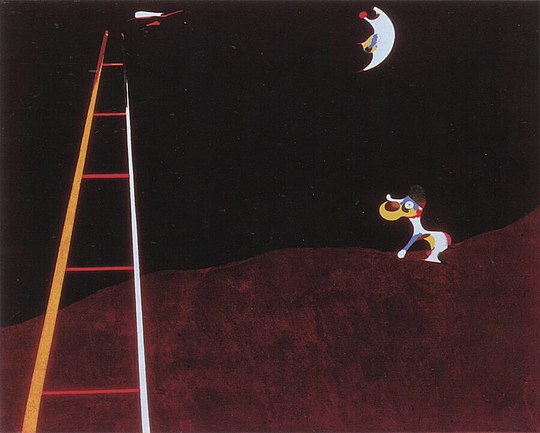
Dog Barking at the Moon (1926) is a vital example of Joan Miró’s skill to combine the whimsical with deep layers of symbolismSymbolism was a late 19th-century art movement of French, Belgian, and Russian origin. Poets and fine artists were seeking to represent absolute truths using metaphorical images in reaction against realism and naturalism. Content of both images and poetry were suggestive contents to express mystical ideas, emotions, and states of mind. Paul Gauguin, Nave Nave Mahana (1869) The term was coined More. It stands out in his abstract and surrealist oeuvre for its simplicity and depth.
- Interpretation of the Painting: The painting shows a dog barking at a half-moon, while a ladder extends into the sky. With its stark background, the picture emphasizes the surreal elements that unfold in the foreground. The dog, with its exaggerated features, appears both comical and poignant.
The ladder could be interpreted as a connection between the earth and the celestial, hinting at unattainable aspirations or dreams. The moon, a recurring motif in Miró’s work, adds a layer of mystery and wonder. - Surrealist Elements: The painting is filled with touches that reflect Miró’s vision of surrealismSurrealism was a 20th-century philosophical, literary, and artistic movement seeking to channel the unconscious to access the imaginary. Proponents of Surrealism rejected the notion of understanding life in rational and conventional terms in favour of asserting the value of the unconscious mind, dreams, the strangely beautiful, and the uncanny. André Breton, the leader of a group of poets and artists More. The unnatural dimension of the elements and the dreamlike quality of the scene transport the viewer into a fantastical world. The simplicity of the composition disguises its complexity. This makes the picture open to a multitude of different interpretations.
Dog Barking at the Moon holds a special place in Miró’s body of work:
- Abstract and Surrealist Repertoire: This painting epitomizes Miró’s mastery of combining surrealismSurrealism was a 20th-century philosophical, literary, and artistic movement seeking to channel the unconscious to access the imaginary. Proponents of Surrealism rejected the notion of understanding life in rational and conventional terms in favour of asserting the value of the unconscious mind, dreams, the strangely beautiful, and the uncanny. André Breton, the leader of a group of poets and artists More with abstraction. It merges everyday imagery with fantastical elements, creating a piece that is deeply thought-provoking.
- Artistic Significance: This picture plays an important role within Joan Miró’s development as an artist. It shows how he continued to explore how to blend the subconscious with reality. It could be a hint at that Miró was fascinated by the power of dreams and the unconscious mind.
This painting is a testament to Miró’s genius, highlighting his unique contribution to modern art and his lasting influence on the surrealist movement.
The Garden (1925)
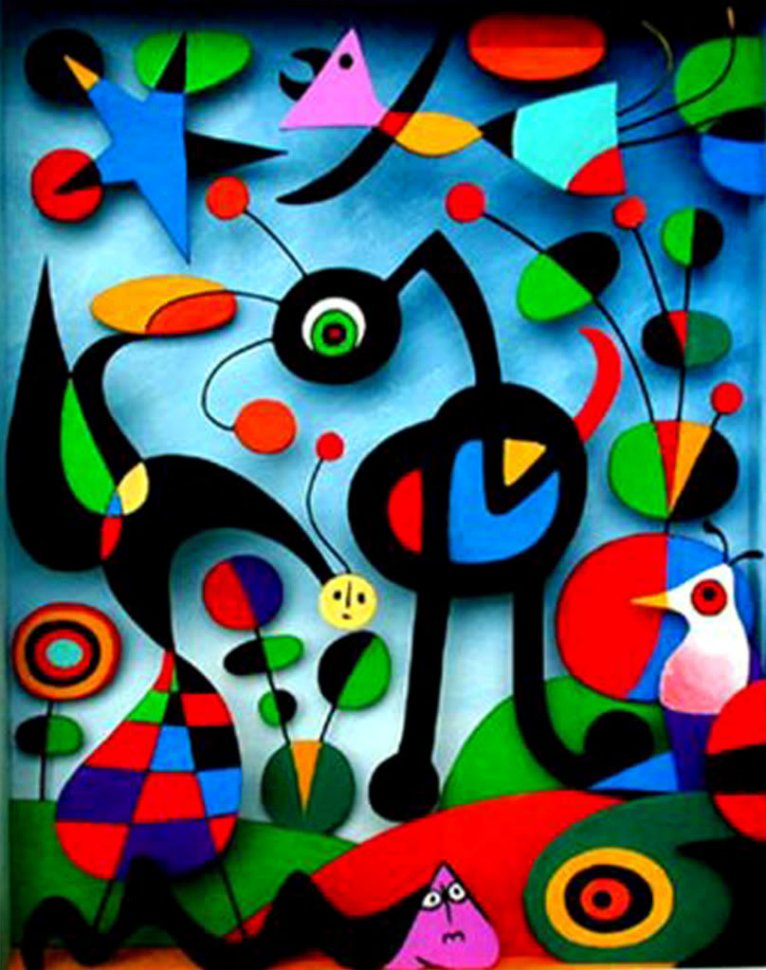
The Garden (1925) by Joan MiróSpanish Catalan artist Joan Miró (1893 – 1983) is famous for his works in painting, sculpture, and ceramics. His work is strongly influenced by his hometown Barcelona, the scenic seaside, and the distinct style of that area. From early on, he was exposed to the arts through his parents’ professions: His mother was a goldsmith, father worked as a watchmaker. More embodies the abstract and whimsical nature of his work. The painting is a vivid example of his unique artistic vision since it combines playful elements with deep symbolic meaning.
- Analysis of Its Abstract and Whimsical Nature:
- Abstract Forms: The painting is filled with abstract shapes and forms that defy conventional representation. Miró uses a mix of lines, dots, and organic shapes to create a lively composition. These forms float and interact in a dreamlike landscape, evoking a sense of spontaneity.
- Whimsical Elements: Miró includes fantastical creatures and surreal objects that populate the garden. These elements add a sense of joy and wonder, making the scene feel like a fantastical world where the boundaries of reality are blurred.
- Color Palette: The use of bright, vibrant colors enhances the painting’s whimsical feel. Miró’s bold use of primary colorsPrimary colors form the foundation of color theory and are essential to understanding how colors work together. The primary colors are red, blue, and yellow. These colors are unique because they cannot be created by mixing other colors together. Instead, they are the source colors that mix to create a broad spectrum of hues used in art, design, and everyday More and contrasting shadesIn color theory, a shade is a darker version of a color, created by adding black to the original hue. This concept is essential for artists and designers, as it allows for a range of deeper, more intense tones that can add depth and drama to a composition. Defining Shade A shade results from mixing a pure hue with black. More creates a dynamic and engaging visual experience.
- How It Reflects Miró’s Unique Artistic Vision:
- SurrealismSurrealism was a 20th-century philosophical, literary, and artistic movement seeking to channel the unconscious to access the imaginary. Proponents of Surrealism rejected the notion of understanding life in rational and conventional terms in favour of asserting the value of the unconscious mind, dreams, the strangely beautiful, and the uncanny. André Breton, the leader of a group of poets and artists More and Abstraction: The Garden is another example of Miró’s ability to merge surrealismSurrealism was a 20th-century philosophical, literary, and artistic movement seeking to channel the unconscious to access the imaginary. Proponents of Surrealism rejected the notion of understanding life in rational and conventional terms in favour of asserting the value of the unconscious mind, dreams, the strangely beautiful, and the uncanny. André Breton, the leader of a group of poets and artists More with abstraction. The abstract forms and surreal elements invite us to engage with the work on a more imaginative level.
- SymbolismSymbolism was a late 19th-century art movement of French, Belgian, and Russian origin. Poets and fine artists were seeking to represent absolute truths using metaphorical images in reaction against realism and naturalism. Content of both images and poetry were suggestive contents to express mystical ideas, emotions, and states of mind. Paul Gauguin, Nave Nave Mahana (1869) The term was coined More: The painting is rich with symbolic meaning. The fantastical creatures and abstract shapes could be understood to represent Miró’s inner world and his creative process. The garden itself can be seen as a metaphor for growth, creativity, and the natural world’s beauty and mystery.
The Garden is a quintessential example of Joan Miró’s artistic vision, blending abstract and whimsical elements to create a captivating and thought-provoking work.
Dutch Interior I, II, III (1928)
The Dutch Interior series (1928) by Joan MiróSpanish Catalan artist Joan Miró (1893 – 1983) is famous for his works in painting, sculpture, and ceramics. His work is strongly influenced by his hometown Barcelona, the scenic seaside, and the distinct style of that area. From early on, he was exposed to the arts through his parents’ professions: His mother was a goldsmith, father worked as a watchmaker. More is a fascinating trio of paintings that reinterprets works from the Dutch Golden Age through the lens of abstraction and surrealismSurrealism was a 20th-century philosophical, literary, and artistic movement seeking to channel the unconscious to access the imaginary. Proponents of Surrealism rejected the notion of understanding life in rational and conventional terms in favour of asserting the value of the unconscious mind, dreams, the strangely beautiful, and the uncanny. André Breton, the leader of a group of poets and artists More. Again, these paintings demonstrate Miró’s ability to blend traditional influences with his contemporary artistic vision.
- Analysis of the Series Inspired by Dutch Golden Age Paintings:
- Source Material: Each painting in the series is inspired by a different work from the Dutch Golden Age. Miró took the typical realistic interiors and transformed them into vibrant, abstract compositions.
- Dutch Interior I: Based on a painting by Hendrick Martensz Sorgh, it features a lute player and a woman in an interior setting.
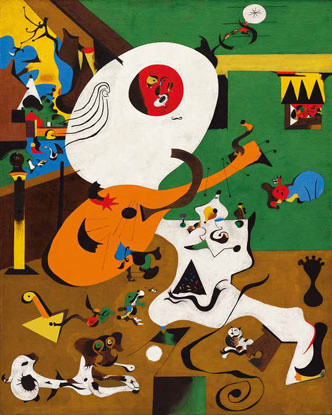
- Dutch Interior II: Draws from Jan Steen’s work, showing a cheerful domestic scene.
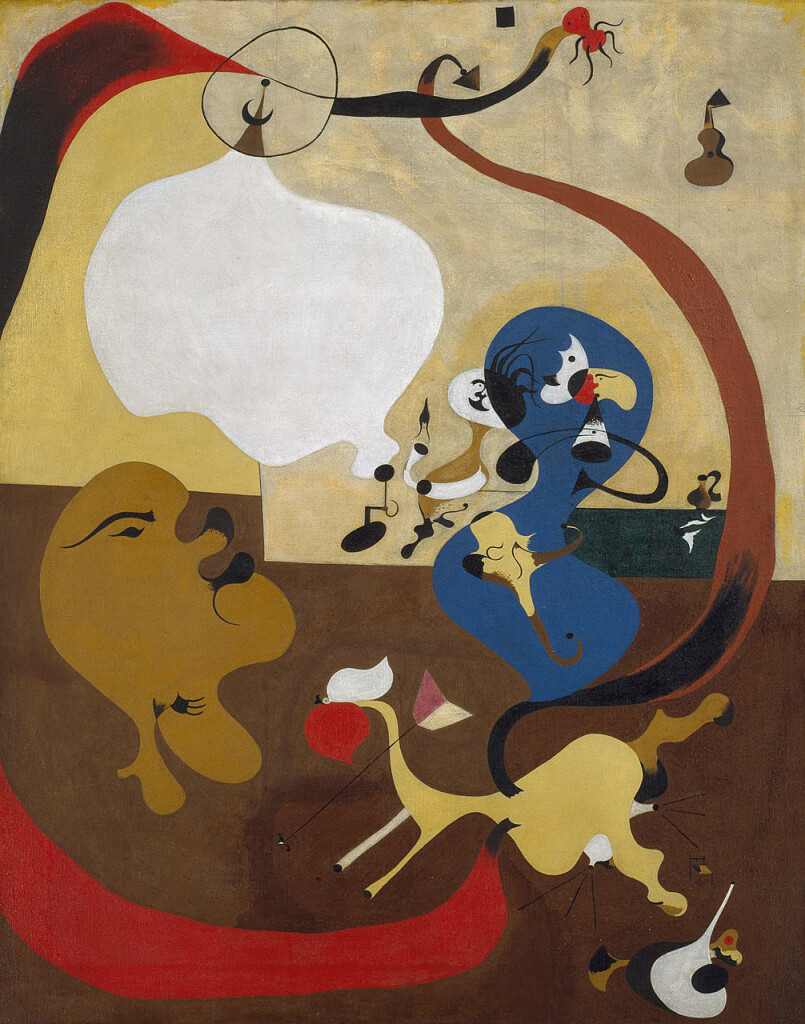
- Dutch Interior III: Inspired by another piece from Sorgh, this picture features a man playing a guitar.
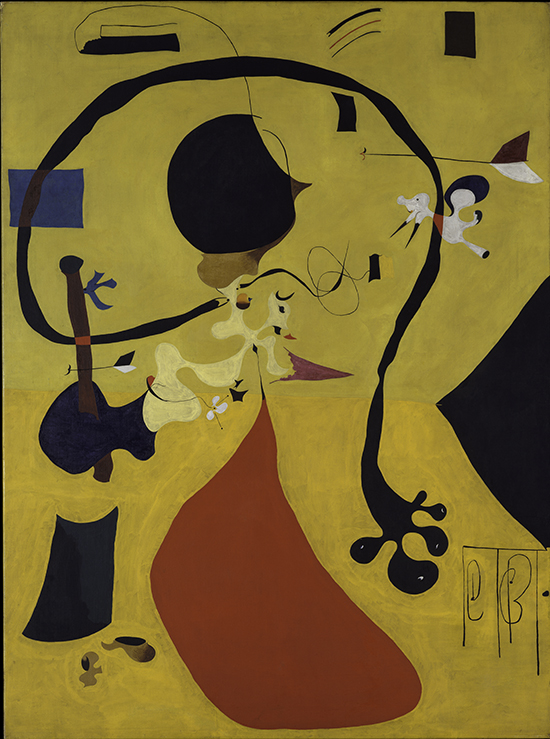
- Transformation: Miró’s reinterpretation involves deconstructing the original compositions and infusing them with surreal elements. He replaces the detailed realismRealism is an art movement that emerged in the mid-19th century, emphasizing the depiction of subjects as they appear in everyday life. It rejects the idealized forms and dramatic expressions of Romanticism, focusing instead on accuracy, truthfulness, and the mundane aspects of the human experience. Realism strives to capture the world in a straightforward and unembellished manner. Gustave Courbet, The More of the Dutch masters with bold colors and whimsical shapes that are typical of Miró’s abstract style.
- Abstraction and SurrealismSurrealism was a 20th-century philosophical, literary, and artistic movement seeking to channel the unconscious to access the imaginary. Proponents of Surrealism rejected the notion of understanding life in rational and conventional terms in favour of asserting the value of the unconscious mind, dreams, the strangely beautiful, and the uncanny. André Breton, the leader of a group of poets and artists More in These Works:
- Abstraction: Miró simplifies the complex scenes of the Dutch interiors into basic forms and strong colors. The detail of the original paintings is distilled into a series of fluid lines and shapes. With this abstraction, he strips away the specifics to focus on the essence of the scenes.
- SurrealismSurrealism was a 20th-century philosophical, literary, and artistic movement seeking to channel the unconscious to access the imaginary. Proponents of Surrealism rejected the notion of understanding life in rational and conventional terms in favour of asserting the value of the unconscious mind, dreams, the strangely beautiful, and the uncanny. André Breton, the leader of a group of poets and artists More: Surreal elements permeate the series, transforming everyday domestic scenes into fantastical visions.
- Playful Imagery: Miró introduces playful, almost childlike elements into the compositions, such as distorted instruments and exaggerated gestures.
- Dreamlike Quality: The paintings evoke a dreamlike quality, with objects floating and interacting in unexpected ways. This approach aligns with the surrealist focus on the unconscious mind and dream states.
- SymbolismSymbolism was a late 19th-century art movement of French, Belgian, and Russian origin. Poets and fine artists were seeking to represent absolute truths using metaphorical images in reaction against realism and naturalism. Content of both images and poetry were suggestive contents to express mystical ideas, emotions, and states of mind. Paul Gauguin, Nave Nave Mahana (1869) The term was coined More and Interpretation: As viewers, we are invited to understand the scenes in new ways. Some of the familiar elements from Dutch interiors can be interpreted in new ways through Miró’s abstract and surreal lens.
The Dutch Interior series is a testament to Joan Miró’s innovative approach to art. By reimagining Dutch Golden Age paintings through abstraction and surrealismSurrealism was a 20th-century philosophical, literary, and artistic movement seeking to channel the unconscious to access the imaginary. Proponents of Surrealism rejected the notion of understanding life in rational and conventional terms in favour of asserting the value of the unconscious mind, dreams, the strangely beautiful, and the uncanny. André Breton, the leader of a group of poets and artists More, Miró bridges the gap between traditional and modern art.
Constellations Series (1940-1941)
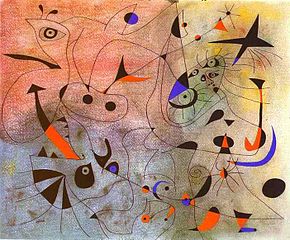
The Constellations Series (1940-1941) is a collection of paintings by Joan MiróSpanish Catalan artist Joan Miró (1893 – 1983) is famous for his works in painting, sculpture, and ceramics. His work is strongly influenced by his hometown Barcelona, the scenic seaside, and the distinct style of that area. From early on, he was exposed to the arts through his parents’ professions: His mother was a goldsmith, father worked as a watchmaker. More that captures his innovative spirit during a turbulent period. Created during World War II, these works are often interpreted to reflect the connection to the cosmos and the longing for peace and stability.
- Overview of the Series: The series comprises 23 paintings, each filled with complex patterns of stars, moons, and other celestial symbols. These pieces were created while Miró was in exile, and they convey a sense of wonder and escape from the chaos of the world. Each painting is a universe unto itself, brimming with vibrant colors and dynamic compositions.
- Themes: Central themes in the Constellations Series include the cosmos, dreams, and the subconscious. Miró used these celestial motifs to express a sense of limitlessness. These themes emphasize Miró’s wish to transcend the present in favor of the vastness of the universe, offering a stark contrast to the earthly turmoil of the war.
- Artistic Techniques: Miró employed a range of innovative techniques in the Constellations Series.
- Automatic Drawing: One key technique was automatic drawing, a method inspired by SurrealismSurrealism was a 20th-century philosophical, literary, and artistic movement seeking to channel the unconscious to access the imaginary. Proponents of Surrealism rejected the notion of understanding life in rational and conventional terms in favour of asserting the value of the unconscious mind, dreams, the strangely beautiful, and the uncanny. André Breton, the leader of a group of poets and artists More, where the artist allows the subconscious to guide the hand. This approach resulted in spontaneous and fluid forms that populate the series.
- Color and Composition: The use of vibrant colors against dark backgrounds creates a striking contrast, making the celestial elements stand out. Miró layered these lines and dots meticulously to give the paintings a sense of depth and movement. It seems as if the stars were swirling in an ever-changing sky.
- SymbolismSymbolism was a late 19th-century art movement of French, Belgian, and Russian origin. Poets and fine artists were seeking to represent absolute truths using metaphorical images in reaction against realism and naturalism. Content of both images and poetry were suggestive contents to express mystical ideas, emotions, and states of mind. Paul Gauguin, Nave Nave Mahana (1869) The term was coined More: The series is rich with symbolic imagery, including birds, eyes, and abstract shapes, each contributing to the dreamlike quality of the works. These symbols invite viewers to explore their own subconscious interpretations. This makes the series personal.
The Constellations Series stands as a testament to Joan Miró’s artistic resilience and creativity. It showcases his ability to find beauty and inspiration even in the darkest times.
Woman Encircled by the Flight of a Bird (1941)
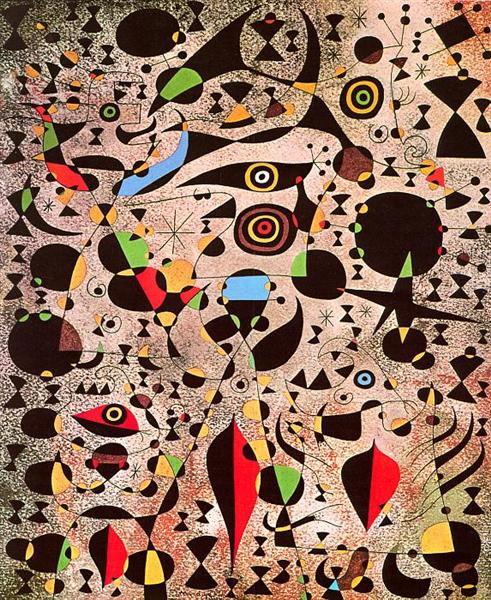
Woman Encircled by the Flight of a Bird (1941) is another key piece in Joan Miró’s oeuvre. Like his other paintings, it is rich in abstract forms and full of symbolic meanings.
Interpretation of Abstract Forms and Symbolic Meanings:
- Abstract Forms: The painting features a central female figure surrounded by fluid, swirling lines and shapes. The woman’s form is simplified and abstract, with exaggerated features and vibrant colors. The bird, represented by sweeping, dynamic lines, creates a sense of motion and encircles the figure
- Symbolic Meanings: The central figure can be interpreted to symbolize femininity and creativity, while the encircling bird might stand for freedom and transcendence. The interplay between the woman and the bird suggests a harmonious relationship between humans and nature. The numerous abstract forms can be understood to stand for transformation and liberation, reflecting Miró’s fascination with the unconscious mind and the mysteries of life.
- Significance in Miró’s Oeuvre:
- Artistic Evolution: This painting is significant in Miró’s body of work as it marks a mature phase in his evolution as an artist. It demonstrates his mastery of combining surrealismSurrealism was a 20th-century philosophical, literary, and artistic movement seeking to channel the unconscious to access the imaginary. Proponents of Surrealism rejected the notion of understanding life in rational and conventional terms in favour of asserting the value of the unconscious mind, dreams, the strangely beautiful, and the uncanny. André Breton, the leader of a group of poets and artists More with abstraction, creating a unique visual language that transcends traditional boundaries.
- Innovative Techniques: The fluid lines and vibrant colors create a dynamic composition that invites us into dreamlike imagination and to come up with own interpretations.
- Influence and Legacy: The abstract and symbolic elements in Woman Encircled by the Flight of a Bird have inspired countless artists and continue to be studied for their artistic and thematic depth. Like the other key pieces in his oeuvre, this painting represents Miró’s ability to convey complex ideas through simple yet powerful imagery.
If you’re exploring Joan Miró’s art, this painting offers a rich, engaging experience that shows his mastery of abstract and surreal forms.
Blue Series (1961)
The Blue Series is a trio of paintings, all created 1961 by Miró. The three paintings, known as Blue I, Blue II and Blue III, are celebrated in the art world as masterpieces of color, space, and form.
- Analysis of the Three Paintings: The paintings in the series all feature a dominant blue background, which serves as a vast canvas for the artist’s abstract forms.
- Blue I: Introduces the series with a large blue expanse, punctuated by a few carefully placed shapes. This picture feels calmer and more reflective than the other ones in this series, creating a sense of calm and introspection.
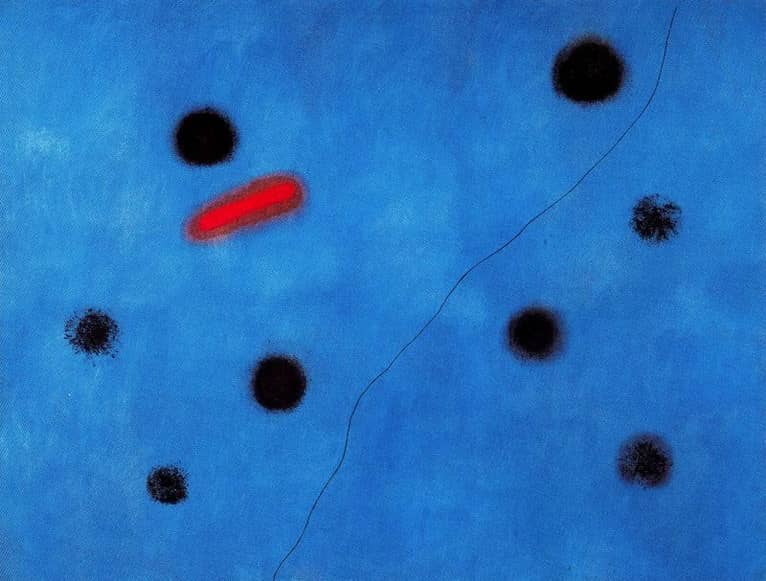
- Blue II: Builds on the theme of the first picture with more action. The forms, although still more basic, interact more actively and suggest movement and tension.
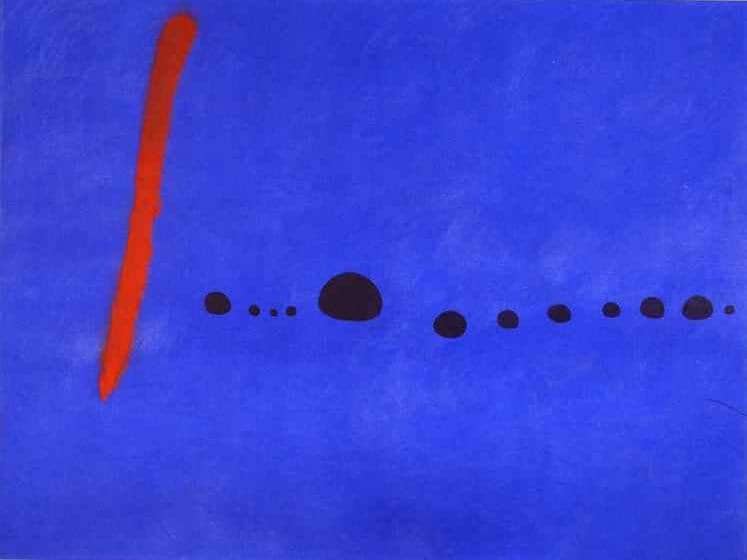
- Blue III: This picture returns to absolute simplicity in color and modesty in form. The sense of calmness is deepened as if the forms have reached more comfort within the newly discovered blue void.
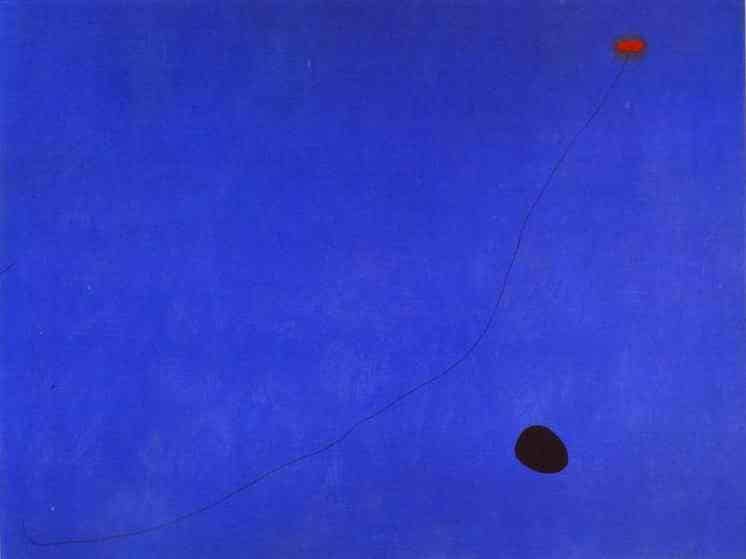
- Importance of Color and Form: Color and form are the protagonists in these three pictures. The blue color is more than background surface, evoking the notion of infinity and serenity. The forms are mostly composed of lines, dots, and organic shapes, contrasting sharply with the blue color. The overall compositions can be understood as striking a balance between the void and the presence of elements.
- Color: The use of blue in all three paintings creates a cohesive theme, symbolizing the vastness of the landscape. This color choice evokes feelings of peace and infinite possibilities. This is a common theme in Miró’s later works.
- Form: The simplicity of the abstract shapes makes them even more potent. Miró’s use of lines and shapes creates a narrative within each painting, allowing the viewer to explore different interpretations. The interplay between the forms and the blue color in the back highlights Miró’s skill in creating meaning with minimal elements.
The Blue Series is a significant part of Joan MiróSpanish Catalan artist Joan Miró (1893 – 1983) is famous for his works in painting, sculpture, and ceramics. His work is strongly influenced by his hometown Barcelona, the scenic seaside, and the distinct style of that area. From early on, he was exposed to the arts through his parents’ professions: His mother was a goldsmith, father worked as a watchmaker. More oeuvre. They demonstrate his ability to convey profound emotions and ideas through minimalistic means. These works are essential for understanding Miró’s approach to abstract art Abstract artworks diverge from depicting recognizable scenes or objects and instead use colors, forms, and lines to create compositions that exist independently of visual references from the natural world. This movement, which gained momentum in the early 20th century, was propelled by artists such as Wassily Kandinsky, Piet Mondrian, and Kazimir Malevich. These artists aimed to explore spiritual, emotional, and More and his influence on the modern art world.
Abstract artworks diverge from depicting recognizable scenes or objects and instead use colors, forms, and lines to create compositions that exist independently of visual references from the natural world. This movement, which gained momentum in the early 20th century, was propelled by artists such as Wassily Kandinsky, Piet Mondrian, and Kazimir Malevich. These artists aimed to explore spiritual, emotional, and More and his influence on the modern art world.
The Gold of the Azure (1967)
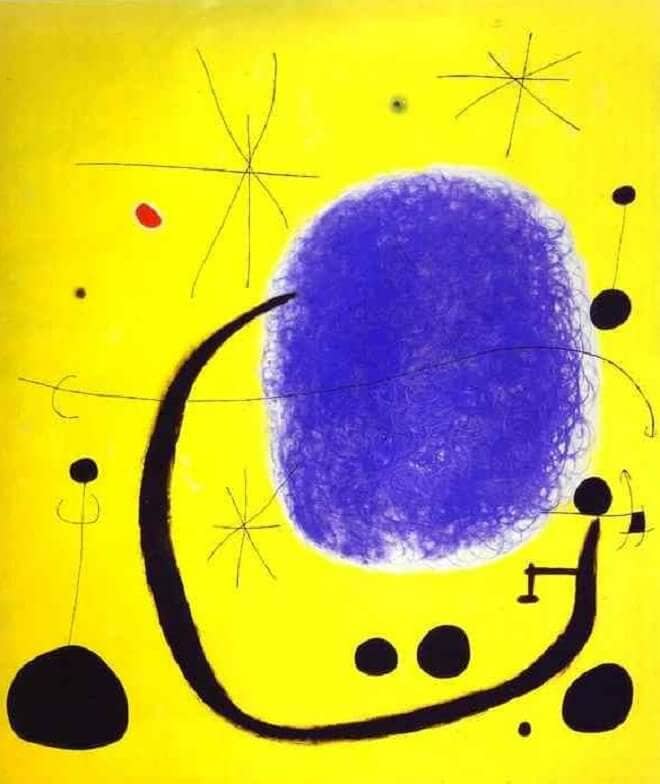
The Gold of the Azure (1967) is a striking example of Joan Miró’s abstract techniques, highlighting his continued innovation in the later stages of his career. This painting captures the essence of his mature style, characterized by bold colors and simplified forms.
- Exploration of Abstract Techniques:
- Use of Color: The painting shows a rich blue background, which Miró often used to evoke a sense of depth and infinity. Against this blue surface, vibrant yellow and gold forms stand out, creating a vivid contrast that draws us in. The use of gold leaf adds a luminous quality, enhancing the visual impact.
- Simplified Forms: Miró employs simplified, almost geometric shapes that float against the blue backdrop. These forms are reminiscent of celestial bodies, suggesting a cosmic theme. The interplay of these shapes creates a dynamic composition that feels both balanced and spontaneous.
- Gesture and Movement: The brushstrokes in The Gold of the Azure are fluid and expressive, capturing a sense of movement and energy. This technique could be understood to convey Miró’s interest in presenting the subconscious mind and the spontaneous creation process.
- Significance in His Later Career:
- Mature Style: This painting exemplifies Miró’s mature style, where he refined his abstract language to its essence. By the 1960s, he had mastered the ability to communicate profound ideas with minimal elements.
- Continued Innovation: Even in his later years, Miró continued to push the boundaries of abstract art
 Abstract artworks diverge from depicting recognizable scenes or objects and instead use colors, forms, and lines to create compositions that exist independently of visual references from the natural world. This movement, which gained momentum in the early 20th century, was propelled by artists such as Wassily Kandinsky, Piet Mondrian, and Kazimir Malevich. These artists aimed to explore spiritual, emotional, and More. This painting shows his willingness to experiment with new materials and techniques, such as the use of gold leaf, which adds a new dimension to his work.
Abstract artworks diverge from depicting recognizable scenes or objects and instead use colors, forms, and lines to create compositions that exist independently of visual references from the natural world. This movement, which gained momentum in the early 20th century, was propelled by artists such as Wassily Kandinsky, Piet Mondrian, and Kazimir Malevich. These artists aimed to explore spiritual, emotional, and More. This painting shows his willingness to experiment with new materials and techniques, such as the use of gold leaf, which adds a new dimension to his work.
The Gold of the Azure reflects the artist’s continuous evolution and his unending search for new artistic territories.
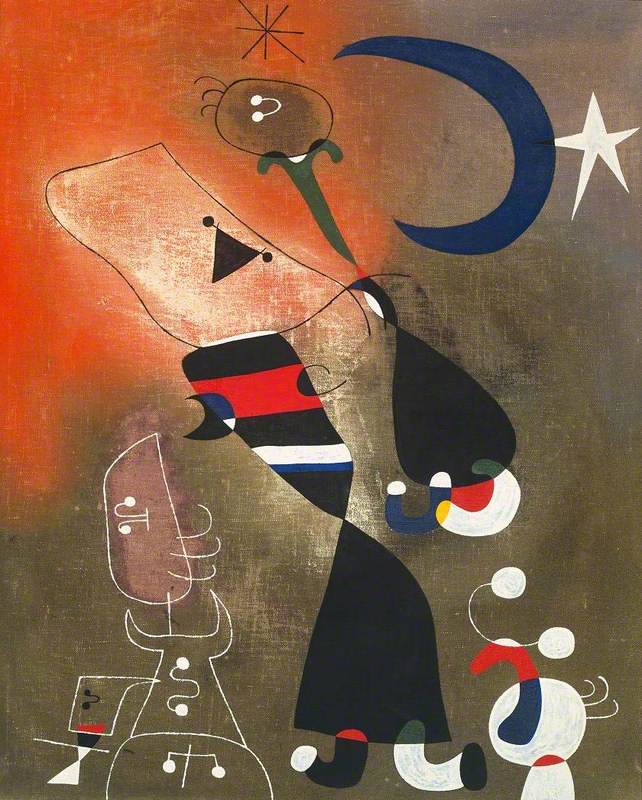
Dive Deeper into Miró’s World
These vibrant colors, playful shapes, and how they magnetically pull you in. Don’t these pictures capture you like a dream?
We’ve explored some of Miró’s most iconic works, each painting a testament to his boundless creativity.
The Farm captures rural life with hints of surrealismSurrealism was a 20th-century philosophical, literary, and artistic movement seeking to channel the unconscious to access the imaginary. Proponents of Surrealism rejected the notion of understanding life in rational and conventional terms in favour of asserting the value of the unconscious mind, dreams, the strangely beautiful, and the uncanny. André Breton, the leader of a group of poets and artists More. Harlequin’s Carnival is a celebration of dreamlike wonder. The Tilled Field and Dog Barking at the Moon blend reality with fantasy. The cosmic scenes in the Constellations Series and the serene Blue Series highlight his mastery of abstract forms. The Gold of the Azure and The Garden showcase the depth of his later works.
Miró’s influence reshaped how we see form and color. His paintings open doors to a universe of imagination.
While a basic understanding of his most important pieces is a good first step, nothing compares to experiencing them in person. Visit museums and galleries to see these masterpieces up close. Stand before them and let them draw you into their magical worlds.
The Fundació Joan MiróSpanish Catalan artist Joan Miró (1893 – 1983) is famous for his works in painting, sculpture, and ceramics. His work is strongly influenced by his hometown Barcelona, the scenic seaside, and the distinct style of that area. From early on, he was exposed to the arts through his parents’ professions: His mother was a goldsmith, father worked as a watchmaker. More in Barcelona and the Museum of Modern Art in New York are great places to start. Witnessing Miró’s vibrant colors and playful shapes firsthand will leave you longing for more.
Recommended Museums and Galleries
- Fundació Joan MiróSpanish Catalan artist Joan Miró (1893 – 1983) is famous for his works in painting, sculpture, and ceramics. His work is strongly influenced by his hometown Barcelona, the scenic seaside, and the distinct style of that area. From early on, he was exposed to the arts through his parents’ professions: His mother was a goldsmith, father worked as a watchmaker. More, Barcelona, Spain
- Museum of Modern Art (MoMA), New York, USA
- Tate Modern, London, UK
- Guggenheim Museum, New York, USA
- Museo Nacional Centro de Arte Reina Sofía, Madrid, Spain

Sources
Erben, W., & Duchting, H. (2012). Miró (Taschen 25th Anniversary). Taschen.
Rowell, M. (Ed.). (1992). Joan Miró: Selected writings and interviews.
Lanchner, C. (2008). Joan Miró (MoMA artist series).
Erben, W. (1976). Joan Miró 1893-1983: The man and his work.
de la Beaumelle, A. (2012). Miró. I’m Going to Smash Their Guitar. Parkstone International.
The Art Story. (n.d.). Joan MiróSpanish Catalan artist Joan Miró (1893 – 1983) is famous for his works in painting, sculpture, and ceramics. His work is strongly influenced by his hometown Barcelona, the scenic seaside, and the distinct style of that area. From early on, he was exposed to the arts through his parents’ professions: His mother was a goldsmith, father worked as a watchmaker. More art, bio, ideas. https://www.theartstory.org/artist/miro-joan/
The Metropolitan Museum of Art. (2004). Joan MiróSpanish Catalan artist Joan Miró (1893 – 1983) is famous for his works in painting, sculpture, and ceramics. His work is strongly influenced by his hometown Barcelona, the scenic seaside, and the distinct style of that area. From early on, he was exposed to the arts through his parents’ professions: His mother was a goldsmith, father worked as a watchmaker. More (1893–1983). https://www.metmuseum.org/toah/hd/miro/hd_miro.htm
Encyclopædia Britannica. (n.d.). Joan MiróSpanish Catalan artist Joan Miró (1893 – 1983) is famous for his works in painting, sculpture, and ceramics. His work is strongly influenced by his hometown Barcelona, the scenic seaside, and the distinct style of that area. From early on, he was exposed to the arts through his parents’ professions: His mother was a goldsmith, father worked as a watchmaker. More. https://www.britannica.com/biography/Joan-Miro
National Gallery of Art. (n.d.). Joan MiróSpanish Catalan artist Joan Miró (1893 – 1983) is famous for his works in painting, sculpture, and ceramics. His work is strongly influenced by his hometown Barcelona, the scenic seaside, and the distinct style of that area. From early on, he was exposed to the arts through his parents’ professions: His mother was a goldsmith, father worked as a watchmaker. More [PDF]. https://www.nga.gov/content/dam/ngaweb/Education/learning-resources/an-eye-for-art/AnEyeforArt-JoanMiro.pdf
Umland, A. (2014). Joan MiróSpanish Catalan artist Joan Miró (1893 – 1983) is famous for his works in painting, sculpture, and ceramics. His work is strongly influenced by his hometown Barcelona, the scenic seaside, and the distinct style of that area. From early on, he was exposed to the arts through his parents’ professions: His mother was a goldsmith, father worked as a watchmaker. More: the assassination of painting? ResearchGate. https://www.researchgate.net/publication/263556650_Joan_Miro_the_assassination_of_painting
Quick Facts and FAQ on Joan Miró and His Masterpieces
Q: What are some of the most famous Joan MiróSpanish Catalan artist Joan Miró (1893 – 1983) is famous for his works in painting, sculpture, and ceramics. His work is strongly influenced by his hometown Barcelona, the scenic seaside, and the distinct style of that area. From early on, he was exposed to the arts through his parents’ professions: His mother was a goldsmith, father worked as a watchmaker. More paintings?
A: Some of the most famous Joan MiróSpanish Catalan artist Joan Miró (1893 – 1983) is famous for his works in painting, sculpture, and ceramics. His work is strongly influenced by his hometown Barcelona, the scenic seaside, and the distinct style of that area. From early on, he was exposed to the arts through his parents’ professions: His mother was a goldsmith, father worked as a watchmaker. More paintings include “The Farm,” “Harlequin’s Carnival,” and “Blue II.” These works showcase his unique blend of surrealismSurrealism was a 20th-century philosophical, literary, and artistic movement seeking to channel the unconscious to access the imaginary. Proponents of Surrealism rejected the notion of understanding life in rational and conventional terms in favour of asserting the value of the unconscious mind, dreams, the strangely beautiful, and the uncanny. André Breton, the leader of a group of poets and artists More and abstraction. “The Farm” captures a detailed rural scene, while “Harlequin’s Carnival” and “Blue II” are more abstract. These pieces are celebrated for their vibrant colors and imaginative forms.
Q: How can Joan MiróSpanish Catalan artist Joan Miró (1893 – 1983) is famous for his works in painting, sculpture, and ceramics. His work is strongly influenced by his hometown Barcelona, the scenic seaside, and the distinct style of that area. From early on, he was exposed to the arts through his parents’ professions: His mother was a goldsmith, father worked as a watchmaker. More art projects for kids help in art education?
A: Joan MiróSpanish Catalan artist Joan Miró (1893 – 1983) is famous for his works in painting, sculpture, and ceramics. His work is strongly influenced by his hometown Barcelona, the scenic seaside, and the distinct style of that area. From early on, he was exposed to the arts through his parents’ professions: His mother was a goldsmith, father worked as a watchmaker. More art projects for kids are a great way to introduce children to abstract and surreal art. These projects encourage creativity and help kids understand the use of color and form. By replicating Miró’s playful and vibrant paintings, children can explore their own artistic ideas. These activities can also make learning about art history fun and engaging.
Q: What is unique about Joan Miró’s art style?
A: Joan Miró’s art style is characterized by its playful, abstract forms and vibrant colors. He often combined elements of surrealismSurrealism was a 20th-century philosophical, literary, and artistic movement seeking to channel the unconscious to access the imaginary. Proponents of Surrealism rejected the notion of understanding life in rational and conventional terms in favour of asserting the value of the unconscious mind, dreams, the strangely beautiful, and the uncanny. André Breton, the leader of a group of poets and artists More with abstract techniques. His works are known for their imaginative quality and often feature whimsical shapes and symbols. This distinctive style sets his paintings apart in the art world.
Q: Can you explain the significance of blue in Joan Miró’s paintings?
A: Blue is a significant color in many Joan MiróSpanish Catalan artist Joan Miró (1893 – 1983) is famous for his works in painting, sculpture, and ceramics. His work is strongly influenced by his hometown Barcelona, the scenic seaside, and the distinct style of that area. From early on, he was exposed to the arts through his parents’ professions: His mother was a goldsmith, father worked as a watchmaker. More paintings, symbolizing the sky and the sea. It is prominently featured in works like “Blue I,” “Blue II,” and “Blue III.” The use of blue creates a sense of depth and infinity in his abstract paintings. This color choice is a hallmark of his mature artistic period.
Q: How did Joan MiróSpanish Catalan artist Joan Miró (1893 – 1983) is famous for his works in painting, sculpture, and ceramics. His work is strongly influenced by his hometown Barcelona, the scenic seaside, and the distinct style of that area. From early on, he was exposed to the arts through his parents’ professions: His mother was a goldsmith, father worked as a watchmaker. More influence other artists like Paul KleePaul Klee (1879-1940) was a Swiss-born painter and graphic artist whose work is associated with expressionism, cubism, and surrealism. Klee's art is characterized by his playful and experimental use of color, line, and form. He produced over 9,000 works, including paintings, drawings, and prints, making significant contributions to modern art. Early Life and Education Born in Münchenbuchsee, Switzerland, Klee showed More and Wassily KandinskyWassily (Vasily) Kandinsky (1866 – 1944) is known as one of the pioneers of abstract modern art. He was born in in Moscow to upper-class parents of mixed ethnic origins. At an early age, Kandinsky showed a rare sensitivity towards music and the arts, which his father strongly supported. Kandinsky decided to study law, ethnography, and economics, and started successfully More?
A: Joan Miró’s paintings had a significant impact on contemporary artists, including Paul KleePaul Klee (1879-1940) was a Swiss-born painter and graphic artist whose work is associated with expressionism, cubism, and surrealism. Klee's art is characterized by his playful and experimental use of color, line, and form. He produced over 9,000 works, including paintings, drawings, and prints, making significant contributions to modern art. Early Life and Education Born in Münchenbuchsee, Switzerland, Klee showed More and Wassily KandinskyWassily (Vasily) Kandinsky (1866 – 1944) is known as one of the pioneers of abstract modern art. He was born in in Moscow to upper-class parents of mixed ethnic origins. At an early age, Kandinsky showed a rare sensitivity towards music and the arts, which his father strongly supported. Kandinsky decided to study law, ethnography, and economics, and started successfully More. Miró’s use of abstract forms and surreal elements inspired these artists to explore similar themes in their own work. The playful and imaginative quality of Miró’s art resonated with the abstract and surrealist movements. His innovative approach continues to influence modern art.
Q: Are there Joan MiróSpanish Catalan artist Joan Miró (1893 – 1983) is famous for his works in painting, sculpture, and ceramics. His work is strongly influenced by his hometown Barcelona, the scenic seaside, and the distinct style of that area. From early on, he was exposed to the arts through his parents’ professions: His mother was a goldsmith, father worked as a watchmaker. More art projects suitable for kids?
A: Yes, there are many Joan MiróSpanish Catalan artist Joan Miró (1893 – 1983) is famous for his works in painting, sculpture, and ceramics. His work is strongly influenced by his hometown Barcelona, the scenic seaside, and the distinct style of that area. From early on, he was exposed to the arts through his parents’ professions: His mother was a goldsmith, father worked as a watchmaker. More art projects for kids that are both fun and educational. These projects often involve creating abstract shapes and vibrant color schemes inspired by Miró’s works. Activities can include painting, drawing, and collage-making, allowing kids to explore their creativity. Such projects are excellent for teaching children about abstract art Abstract artworks diverge from depicting recognizable scenes or objects and instead use colors, forms, and lines to create compositions that exist independently of visual references from the natural world. This movement, which gained momentum in the early 20th century, was propelled by artists such as Wassily Kandinsky, Piet Mondrian, and Kazimir Malevich. These artists aimed to explore spiritual, emotional, and More and encouraging imaginative thinking.
Abstract artworks diverge from depicting recognizable scenes or objects and instead use colors, forms, and lines to create compositions that exist independently of visual references from the natural world. This movement, which gained momentum in the early 20th century, was propelled by artists such as Wassily Kandinsky, Piet Mondrian, and Kazimir Malevich. These artists aimed to explore spiritual, emotional, and More and encouraging imaginative thinking.
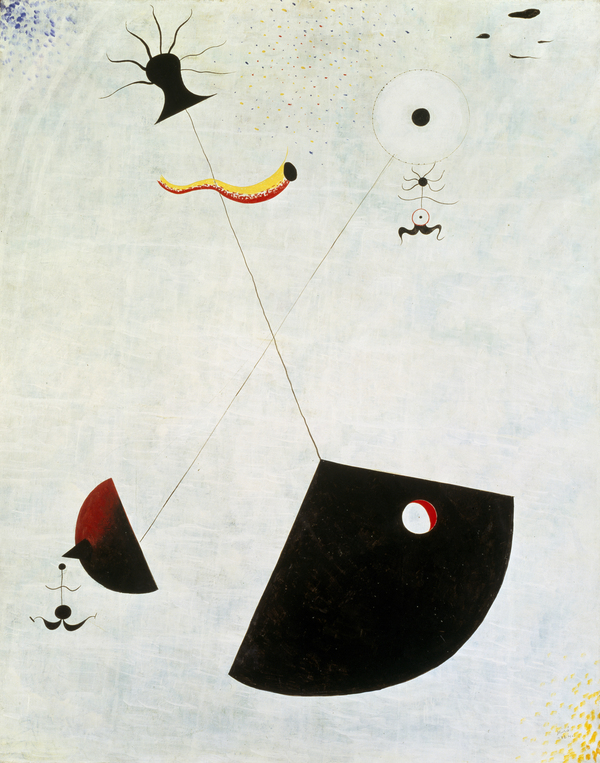
Q: What are some ideas for Joan MiróSpanish Catalan artist Joan Miró (1893 – 1983) is famous for his works in painting, sculpture, and ceramics. His work is strongly influenced by his hometown Barcelona, the scenic seaside, and the distinct style of that area. From early on, he was exposed to the arts through his parents’ professions: His mother was a goldsmith, father worked as a watchmaker. More art lessons?
A: Joan MiróSpanish Catalan artist Joan Miró (1893 – 1983) is famous for his works in painting, sculpture, and ceramics. His work is strongly influenced by his hometown Barcelona, the scenic seaside, and the distinct style of that area. From early on, he was exposed to the arts through his parents’ professions: His mother was a goldsmith, father worked as a watchmaker. More art lessons can include studying his famous paintings, exploring his use of color and form, and creating artworks inspired by his style. Lessons can focus on his surreal and abstract techniques. Teachers can incorporate activities like drawing, painting, and sculptureSculpture refers to a three-dimensional art form created by shaping or combining materials. Sculptors use various techniques to carve, model, cast, or construct their works, resulting in pieces that can be viewed from multiple angles. History and Origin Sculpture has a long history, dating back to prehistoric times. Early humans carved figures from stone, bone, and wood. These early sculptures More to help students understand his artistic process. These lessons are great for developing creative skills and art appreciation.
Q: What is the significance of Joan Miró’s sculptures?
A: Joan Miró’s sculptures are an essential part of his artistic output, reflecting his exploration of three-dimensional forms. These works often feature the same whimsical and abstract elements found in his paintings. His sculptures are known for their playful shapes and use of various materials. They expand on his surreal and imaginative vision in a tangible form.
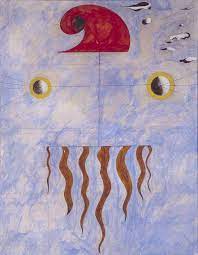
You might enjoy reading further articles by Pigment Pool:
Joan Miró Art Projects for Kids and Adults: Creative Fun for All Ages
Pop Art Ideas: Easy Painting Techniques to Capture the Warhol Essence
Fine Art, Finer Returns: Building a Solid Art Investment Strategy in 2024
How to Create Post-Impressionism Art: Easy Steps to Vibrant Paintings
Guillaume Apollinaire, Surrealism and Today’s AI: Above Reality
Full Disclosure: Clicking on product links could mean a tiny commission for me, at no extra cost to you.
